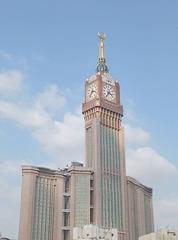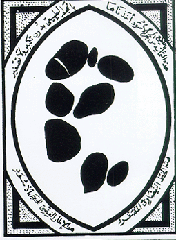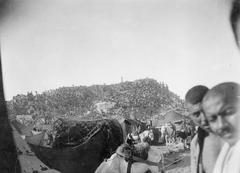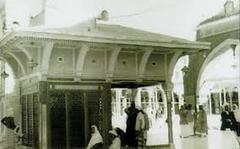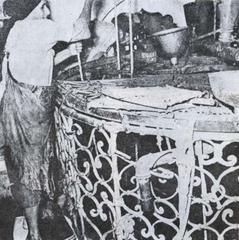Visiting the Corners of the Kaaba: Mecca, Saudi Arabia—Comprehensive Guide on Visiting Hours, Tickets, and Nearby Attractions
Date: 04/07/2025
Introduction: The Kaaba and Its Lasting Significance
The Kaaba, located in the heart of Masjid al-Haram in Mecca, Saudi Arabia, is the most sacred site in Islam. Every year, millions of Muslims visit this revered structure for Hajj, Umrah, and personal spiritual renewal. The Kaaba’s four corners—each with unique names, orientations, and religious significance—serve as both physical and symbolic anchors for Islamic faith and unity. Among these, the southeastern corner, housing the Black Stone (Rukn al-Aswad), holds paramount importance as the starting and ending point of the Tawaf ritual. The southwestern Yemeni Corner (Rukn al-Yamani) is also highly venerated, while the other two corners (Rukn al-Shami and Rukn al-Iraqi) symbolically link the Kaaba to the broader Islamic world.
This guide provides a thorough exploration of the Kaaba’s origins, architecture, and the ritual significance of its corners. In addition, it offers practical information on visiting hours, tickets, accessibility, and nearby attractions—ensuring a well-prepared and meaningful experience, whether your journey is spiritual or cultural. For further insights, see Alimaan Online, Islamic Digest, and the official Saudi Ministry of Hajj and Umrah.
Table of Contents
- Introduction
- Origins and Early History of the Kaaba
- Structure and Dimensions
- The Four Corners: Names, Locations, and Symbolism
- Rituals at the Corners
- Architectural Preservation and Kiswah
- Visiting Information
- Etiquette and Conduct
- Frequently Asked Questions (FAQ)
- Visual and Interactive Resources
- Conclusion
- References
Origins and Early History of the Kaaba
Islamic tradition holds that the Kaaba was first built by Prophet Ibrahim (Abraham) and his son Ismail (Ishmael) as a sanctuary dedicated to the worship of the One God (Alimaan Online). The Quran states:
“And remember Ibrahim and Ismail raised the foundations of the House (with this prayer): ‘Our Lord! Accept (this service) from us: For Thou art the All-Hearing, the All-Knowing.‘” (Quran 2:127)
Over centuries, the Kaaba evolved architecturally and was central to both pre-Islamic trade and post-Islamic pilgrimage (Scientific Origin).
Structure and Dimensions
The Kaaba is a cuboid structure, approximately 15 meters high and 10.5 meters per side, built from dark bluish-grey stone (Smarthistory). Its door, made of solid gold, is elevated about two meters above ground. The Kaaba is draped with the Kiswah, a black silk cloth embroidered with gold Qur’anic inscriptions, which is replaced annually (Alimaan Online).
The Four Corners: Names, Locations, and Symbolism
Each corner of the Kaaba is named for the direction it faces or for a sacred object it contains, and each holds distinct significance (Islamic Digest):
- Rukn al-Aswad (Black Stone Corner, Southeast): Contains the Black Stone (Hajar al-Aswad), the Tawaf’s starting and ending point.
- Rukn al-Yamani (Yemeni Corner, Southwest): Faces Yemen; touched during Tawaf following the Prophet’s Sunnah.
- Rukn al-Shami (Levantine/Syrian Corner, Northwest): Faces the Levant region.
- Rukn al-Iraqi (Iraqi Corner, Northeast): Faces Iraq.
These corners symbolize the Kaaba’s centrality and its connection to the wider Muslim ummah (Islamic Digest).
Rukn al-Aswad (Black Stone Corner)
Located at the southeastern corner, it houses the Black Stone—a revered relic believed to have descended from Paradise (Alimaan Online). Pilgrims begin and end Tawaf here, striving to touch or kiss the Black Stone or gesture toward it if crowds prevent direct contact (behalaltravels.com).
Rukn al-Yamani (Yemeni Corner)
Facing Yemen, this corner is the only other one touched by the Prophet during Tawaf. Pilgrims are encouraged to touch it if possible, but not to kiss or gesture if unable to reach (hajjumrahplanner.com). Between this corner and the Black Stone, pilgrims recite:
“Our Lord, give us in this world [that which is] good and in the Hereafter [that which is] good and protect us from the punishment of the Fire.” (Quran 2:201)
The base of the Rukn al-Yamani is left uncovered by the Kiswah so pilgrims can maintain the tradition of direct contact.
Rukn al-Shami (Levantine/Syrian Corner)
This corner faces the Levant and is part of the continuous Tawaf path, though it is not associated with specific rituals (thepilgrim.co).
Rukn al-Iraqi (Iraqi Corner)
Facing Iraq, the Iraqi Corner completes the Kaaba’s orientation towards early Islamic regions and lies after the Kaaba’s door (lifeinsaudiarabia.net).
Rituals at the Corners
Tawaf and Corner Practices
Tawaf is performed by walking around the Kaaba seven times counterclockwise, starting and ending at the Black Stone. The prescribed actions at each corner are:
| Corner Name | Ritual Action | Etiquette/Notes |
|---|---|---|
| Black Stone (East) | Kiss, touch, or gesture | Start/end Tawaf here; do not push; Sunnah, not obligatory |
| Iraqi (North) | None specific | Continue prayers and supplications |
| Shami (West) | None specific | Continue prayers and supplications |
| Yemeni (South) | Touch with right hand | No kissing/gesturing if unable to touch; recite special supplication to Black Stone |
Touching the Black Stone and Yemeni Corner is Sunnah, not obligatory; safety should always be prioritized (JustUmrah).
Special Supplications
Between the Yemeni Corner and the Black Stone, pilgrims recite the supplication from Quran 2:201, seeking goodness in this world and the Hereafter (CSO Yemen).
Architectural Preservation and Kiswah
The Kaaba has been restored through the centuries, with notable reconstructions after floods and natural disasters (World History Edu). The Kiswah, weighing around 670 kg, is replaced annually (lifeinsaudiarabia.net), and the Rukn al-Yamani’s stone has been reinforced to preserve the touch tradition.
Visiting Information
Visiting Hours
The Masjid al-Haram is open 24/7 for prayer and Tawaf. Access to the Mataf (Tawaf area) may be regulated during peak seasons, such as Hajj and Ramadan.
Tickets and Entry
There is no ticket fee for entry to the mosque or the Kaaba courtyard. However, pilgrims must have valid visas for Hajj or Umrah, and special permits are required for entering the Kaaba interior (Saudi Ministry of Hajj and Umrah).
Accessibility
The mosque is equipped with ramps, elevators, wheelchair services, and dedicated prayer areas for visitors with disabilities. Elderly and disabled pilgrims are assisted by staff and volunteers.
Travel Tips
- Best Times: Early mornings or late evenings outside peak seasons are less crowded (tripjive.com).
- Dress Code: Ihram for men; modest attire and headscarf for women (Outlook Traveller).
- Health & Safety: Stay hydrated, wear comfortable shoes, and follow on-site instructions.
- Transport: The Grand Mosque is accessible via Mecca’s public transport and taxis.
Nearby Attractions
- Mount Arafat: Site of the Hajj standing ritual.
- Jabal al-Nour: Location of the Cave of Hira.
- Museum of the Two Holy Mosques: Islamic history exhibitions.
Etiquette and Conduct
- Respect Sacredness: Maintain quiet, avoid disruptive behavior, and refrain from prohibited photography (Audiala).
- Ritual Cleanliness: Perform Wudu before Tawaf.
- Legal Restrictions: Only Muslims are permitted entry to Masjid al-Haram (Haramain Renter). Prohibited items include alcohol and non-halal food.
Frequently Asked Questions (FAQ)
Q: What are the Kaaba visiting hours?
A: Masjid al-Haram is open 24/7, but early mornings and late nights are best to avoid crowds.
Q: Are tickets needed to visit the Kaaba?
A: No tickets are required for mosque entry, but valid visas and, for special rituals, official permission are necessary.
Q: What is the best time to visit?
A: Early mornings or late evenings during off-peak times.
Q: Is the Kaaba accessible for people with disabilities?
A: Yes, the mosque provides wheelchair services and assistance.
Q: Can non-Muslims visit the Kaaba?
A: No, entry is restricted to Muslims only.
Q: Is photography allowed?
A: Photography and videography are strictly prohibited inside the mosque.
Visual and Interactive Resources
- Official Masjid al-Haram website: Virtual tours and visual resources.
- [Insert images]: Use high-quality, appropriately tagged images such as “Black Stone Corner of the Kaaba” and “Kaaba aerial view” for accessibility and SEO.
- Makkah Travel Guide
- Islamic Landmarks
Conclusion
The Kaaba’s four corners are profound embodiments of Islamic faith, unity, and history. From the celestial Black Stone to the Sunnah of touching the Yemeni Corner, each element deepens the spiritual journey of Hajj and Umrah. By understanding the heritage, rituals, and practical aspects of visiting the Kaaba, pilgrims and visitors can ensure a respectful and fulfilling experience.
For further exploration, updates, and guided tours, download the Audiala app and follow our channels. Prepare for your spiritual journey with knowledge and reverence, and embrace the enduring legacy of the Kaaba at the heart of Islam.
References
- Alimaan Online
- Islamic Digest
- Saudi Ministry of Hajj and Umrah
- Grand Mosque Information
- Scientific Origin
- Life in Saudi Arabia - 13 Sights of Holy Kaaba
- Life in Saudi Arabia - Rukn-e-Yamani Holy Kaaba
- JustUmrah
- CSO Yemen
- World History Edu
- behalaltravels.com
- thepilgrim.co
- Haramain Renter
- Outlook Traveller
- Audiala
- tripjive.com
- blog.almosafer.com
